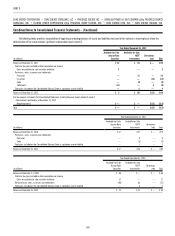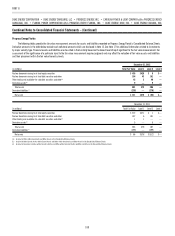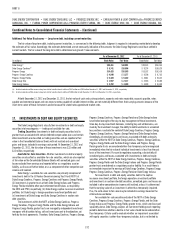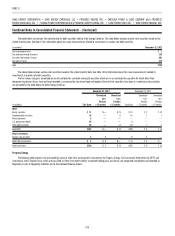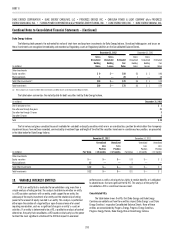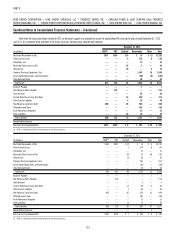Duke Energy 2012 Annual Report Download - page 212
Download and view the complete annual report
Please find page 212 of the 2012 Duke Energy annual report below. You can navigate through the pages in the report by either clicking on the pages listed below, or by using the keyword search tool below to find specific information within the annual report.
192
PART II
DUKE ENERGY CORPORATION • DUKE ENERGY CAROLINAS, LLC • PROGRESS ENERGY, INC. • CAROLINA POWER & LIGHT COMPANY d/b/a PROGRESS ENERGY
CAROLINAS, INC. • FLORIDA POWER CORPORATION d/b/a PROGRESS ENERY FLORIDA, INC. • DUKE ENERGY OHIO, INC. • DUKE ENERGY INDIANA, INC.
Combined Notes to Consolidated Financial Statements – (Continued)
Additional Fair Value Disclosures — Long-term debt, including current maturities:
The fair value of long-term debt, including current maturities, is summarized in the following table. Judgment is required in interpreting market data to develop
the estimates of fair value. Accordingly, the estimates determined are not necessarily indicative of the amounts the Duke Energy Registrants could have settled in
current markets. The fair value of the long-term debt is determined using Level 2 measurements.
As of December 31, 2012 As of December 31, 2011
(in millions) Book Value Fair Value Book Value Fair Value
Duke Energy(a) $39,461 $44,001 $20,573 $23,053
Duke Energy Carolinas(b) $ 8,741 $10,096 $ 9,274 $10,629
Progress Energy $14,428 $16,563 $13,152 $15,518
Progress Energy Carolinas $ 4,840 $ 5,277 $ 4,206 $ 4,735
Progress Energy Florida $ 5,320 $ 6,222 $ 4,681 $ 5,633
Duke Energy Ohio $ 1,997 $ 2,117 $ 2,555 $ 2,688
Duke Energy Indiana $ 3,702 $ 4,268 $ 3,459 $ 4,048
(a) Includes book value of Non-recourse long-term debt of variable interest entities of $852 million and $949 million December 31, 2012 and December 31, 2011, respectively.
(b) Includes book value of Non-recourse long-term debt of variable interest entities of $300 million at both December 31, 2012 and December 31, 2011, respectively.
At both December 31, 2012 and December 31, 2011, the fair value of cash and cash equivalents, accounts and notes receivable, accounts payable, notes
payable and commercial paper and non-recourse notes payable of variable interest entities are not materially different from their carrying amounts because of the
short-term nature of these instruments and/or because the stated rates approximate market rates.
17. INVESTMENTS IN DEBT AND EQUITY SECURITIES
The Duke Energy Registrants classify their investments in debt and equity
securities into two categories — trading and available-for-sale.
Trading Securities. Investments in debt and equity securities held in
grantor trusts associated with certain deferred compensation plans and certain
other investments are classifi ed as trading securities and are reported at fair
value in the Consolidated Balance Sheets with net realized and unrealized
gains and losses included in earnings each period. At December 31, 2012 and
December 31, 2011, the fair value of these investments was $ 33 million and
$32 million, respectively.
Available for Sale Securities. All other investments in debt and equity
securities are classifi ed as available-for-sale securities, which are also reported
at fair value on the Consolidated Balance Sheets with unrealized gains and
losses excluded from earnings and reported either as a regulatory asset or
liability, as discussed further below, or as a component of other comprehensive
income until realized.
Duke Energy’s available-for-sale securities are primarily comprised of
investments held in the (i) Nuclear Decommissioning Trust Fund (NDTF) at
Duke Energy Carolinas, Progress Energy Carolinas and Progress Energy Florida,
(ii) investments in grantor trusts at both Duke Energy Indiana and Progress
Energy Florida related to other post-retirement benefi t plans as required by
the IURC and FPSC, respectively, (iii) Duke Energy captive insurance investment
portfolio, (iv) Duke Energy’s foreign operations investment portfolio and
(v) investments of Duke Energy and Duke Energy Carolinas in auction rate
debt securities.
The investments within the NDTF at Duke Energy Carolinas, Progress
Energy Carolinas, Progress Energy Florida and the Duke Energy Indiana and
Progress Energy Florida grantor trusts are managed by independent investment
managers with discretion to buy, sell and invest pursuant to the objectives set
forth by the trust agreements. Therefore, Duke Energy Carolinas, Progress Energy,
Progress Energy Carolinas, Progress Energy Florida and Duke Energy Indiana
have limited oversight of the day-to-day management of these investments.
Since day-to-day investment decisions, including buy and sell decisions, are
made by the investment manager, the ability to hold investments in unrealized
loss positions is outside the control of Duke Energy Carolinas, Progress Energy,
Progress Energy Carolinas, Progress Energy Florida and Duke Energy Indiana.
Accordingly, all unrealized gains and losses associated with debt and equity
securities within the NDTF at Duke Energy Carolinas, Progress Energy Carolinas,
Progress Energy Florida and the Duke Energy Indiana and Progress Energy
Florida grantor trusts are considered other-than-temporary and are recognized
immediately when the fair value of individual investments is less than the cost
basis of the investment. Pursuant to regulatory accounting, substantially all
unrealized gains and losses associated with investments in debt and equity
securities within the NDTF at Duke Energy Carolinas, Progress Energy Carolinas,
Progress Energy Florida and the Duke Energy Indiana and Progress Energy Florida
grantor trusts are deferred as a regulatory asset or liability. As a result there is
no immediate impact on the earnings of Duke Energy Carolinas, Progress Energy,
Progress Energy Carolinas, Progress Energy Florida or Duke Energy Indiana.
For investments in debt and equity securities held in the captive
insurance investment portfolio, the foreign operations investment portfolio
and investments in auction rate debt securities, unrealized gains and losses are
included in other comprehensive income until realized, unless it is determined
that the carrying value of an investment is other-than-temporarily impaired.
If so, the write-down to fair value may be included in earnings based on the
criteria discussed below.
For available-for-sale securities outside of the NDTF at Duke Energy
Carolinas, Progress Energy Carolinas, Progress Energy Florida, and the Duke
Energy Indiana and Progress Energy Florida grantor trusts, which are discussed
separately above, Duke Energy analyzes all investment holdings each reporting
period to determine whether a decline in fair value should be considered other-
than-temporary. Criteria used to evaluate whether an impairment associated
with equity securities is other-than-temporary includes, but is not limited to,





